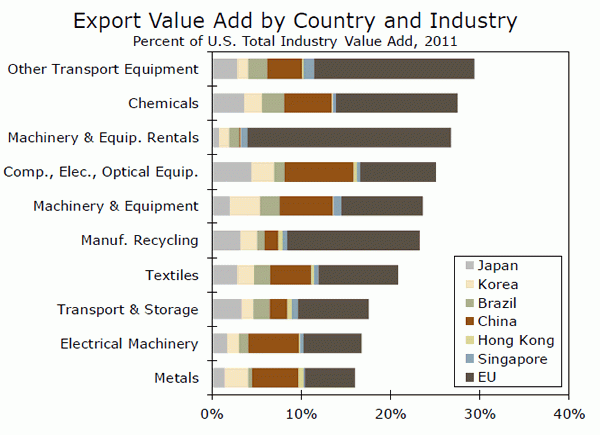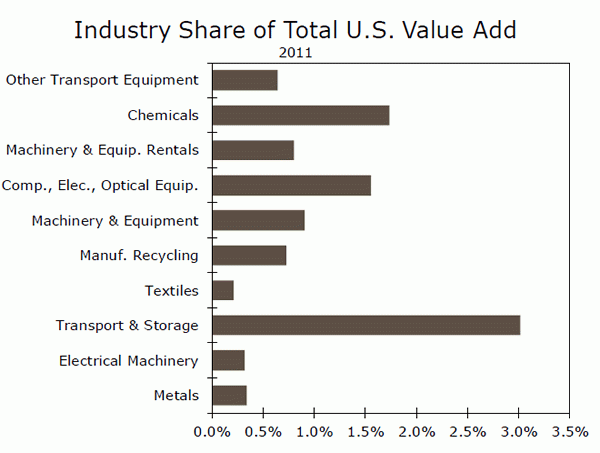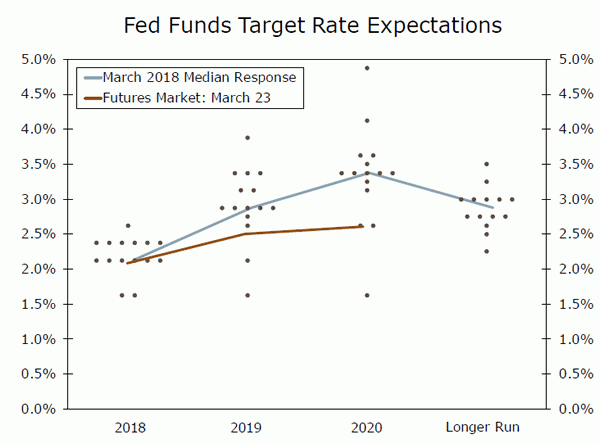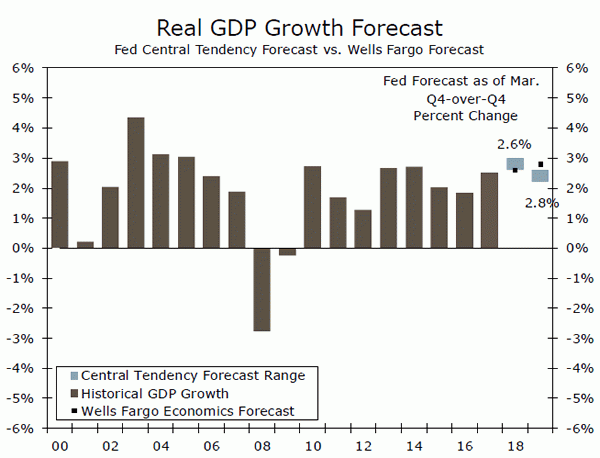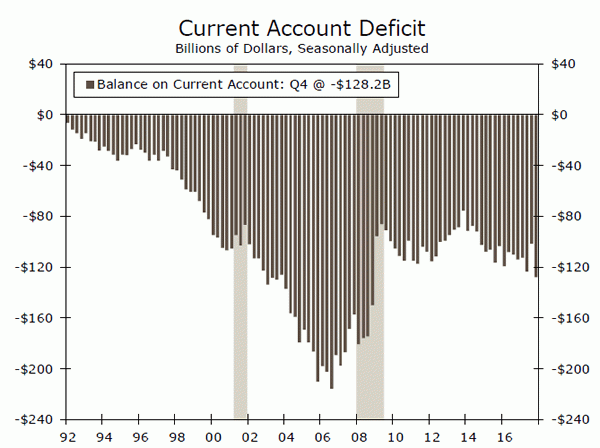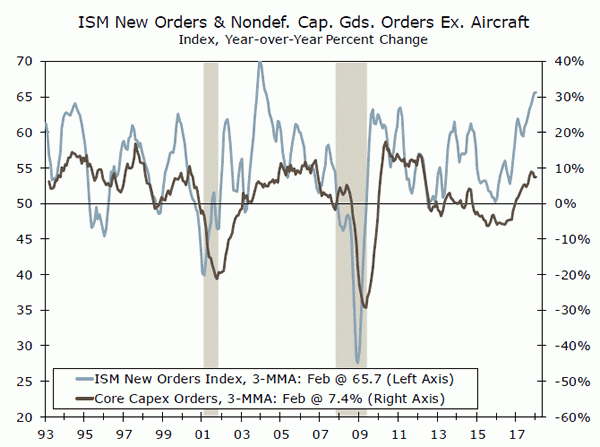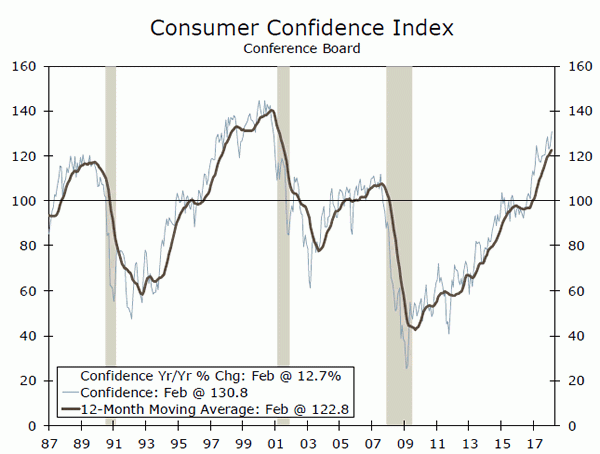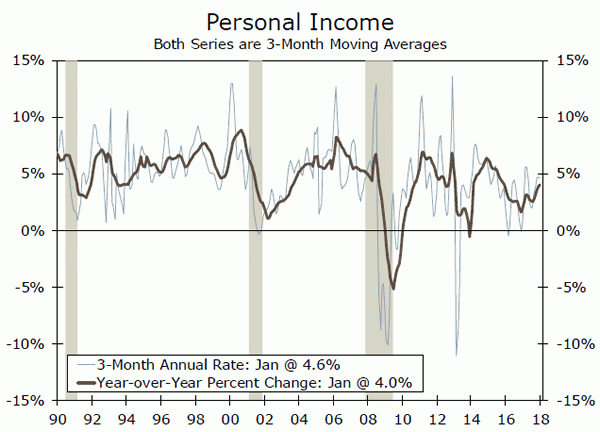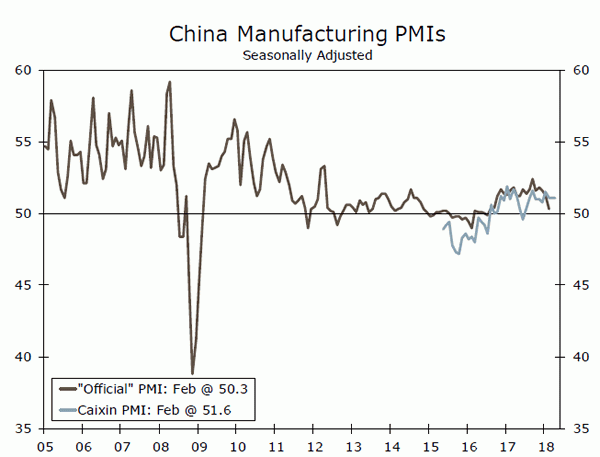U.S. Review
Fed Rate Hikes Remain on Path
- The Fed raised the federal funds rate one quarter of a percentage point to 1.75 percent on Wednesday in a widely expected move, despite less-than-stellar economic data reported so far in Q1. Looking further ahead, seven Fed members now expect four or more rate hikes in 2018, three more than did in December.
- The U.S. current account deficit widened in Q4 to a nine-year high of $128.2 billion, with expectations of further widening this year as the dollar weakens. Durable goods orders rose 3.1 percent in February, much stronger than the consensus 1.6 percent estimate following a weak prior two months.
Fed Rate Hikes Remain on Path
In a somewhat quiet week for economic indicators, the leading story was clearly the FOMC’s decision to raise the federal funds rate. The Fed raised the upper bound limit one quarter of a percentage point to 1.75 percent on Wednesday in a widely expected move, despite less-than-stellar economic data in Q1. Business fixed investment and household spending moderated from Q4, the policy statement acknowledged, but an upgrade to labor market conditions encouraged the FOMC. The decision to continue rate hikes amid softer economic data affirms the Fed’s confidence in this economy’s underlying strength and its determination to normalize rates. Looking further ahead, seven Fed members now expect four or more rate hikes in 2018, three more than did in December. A majority of Fed members now expect three hikes in 2019, up from two hikes in December. We expect economic growth to continue building momentum, and look for three more hikes in 2018, followed by two additional increases in 2019.
The U.S. current account deficit widened in Q4 to a nine-year high of $128.2 billion. The entire deficit comes from the goods sector, with a $214.3 billion deficit, which was partially offset by a $60.4 billion surplus in international services trade. Foreigners made $54.1 billion of direct investment in the U.S. current account in Q4, gladly financing the deficit. We expect the current account deficit to widen further, weighing more on the greenback in 2018.
Existing home sales bounced back from January’s 3.2 percent drop with a 3.0 percent gain in February. The rise in home sales was largely driven by warm weather in the West and South, allowing for more home buying activity in the month. Weather in the Northeast and Midwest was a different story, with snowstorms causing declines in home sales. New home sales decreased slightly in February from a 622,000-unit pace to a 618,000-unit pace. January’s 7.8 percent drop was revised to a 4.7 percent decline. Housing demand is strong behind job and income growth, but supply shortages are limiting the pace of growth to moderate. The lack of inventory is particularly pointed in lower-priced homes, keeping first-time buyers on the sidelines. The low inventory has driven prices up rapidly and is causing homes to be on the market for a shorter amount of time. Consumers are increasingly viewing now as a good time to sell a home as prices run up and demand strengthens, which could ease supply concerns.
Durable goods orders rose 3.1 percent in February, much stronger than the consensus 1.6 percent estimate following a weak prior two months. Core capital goods orders were particularly strong this month, doubling market expectations and rising 1.8 percent, ex-aircraft and defense. Manufacturing output increased a solid 1.2 percent in February, which foreshadowed the strength in core orders. The gap between the sky-high soft survey data and the hard data such as spending and orders was narrowed in February, but remains wider than historical norms. Though today’s report was encouraging, equipment spending has moderated, and we expect real equipment spending to come in at a 7 percent pace in Q1 following last year’s strong finish.
U.S. Outlook
Consumer Confidence • Tuesday
The Consumer Confidence Index gained 6.5 points in February to reach its highest level since late 2000, at 130.8. Consumers’ assessment of the present situation and expectations for the future both rose solidly. The job market was the main driver of the surge in confidence about the present, with the share reporting that jobs are plentiful jumping to the highest of the expansion. Meanwhile, the share reporting that jobs are hard to get fell to a cycle low.
Rising expectations came from improved consumer outlooks on business conditions, employment and income. New tax withholding tables took effect in February, which likely helped boost the share expecting higher incomes 3.2 points to 23.8 percent, a cycle high. Strength in the job market is likely to continue to support confidence ahead. Nonfarm payrolls rose 313,000 in February, above the three-month average of 242,000, and wage growth has picked up.
Previous: 130.8 Wells Fargo: 129.8 Consensus: 131.0
Pending Home Sales • Wednesday
Pending home sales plunged 4.7 percent in January, after three months of modest gains. January’s drop brought the index to its lowest level since 2014. The NAHB/Wells Fargo Housing Market Index, which measures homebuilder confidence, has remained steady at a healthy level. This suggests that demand for homes is not a main barrier to sales. Rather, cold weather and a low inventory of homes available for sale likely weighed on home buying in January. Declines in initial contract signings were most pronounced in the Northeast and Midwest, where cold temperatures in early January would have had the largest effect.
As Spring arrives, the risk of cold weather depressing home sales will diminish. However, low inventories remain a consistent barrier to a significant upturn in pending home sales. A shortage of construction workers and higher materials costs, among factors, have continued to hold back new construction.
Previous: -4.7% Consensus: 2.0% (Month-over-Month)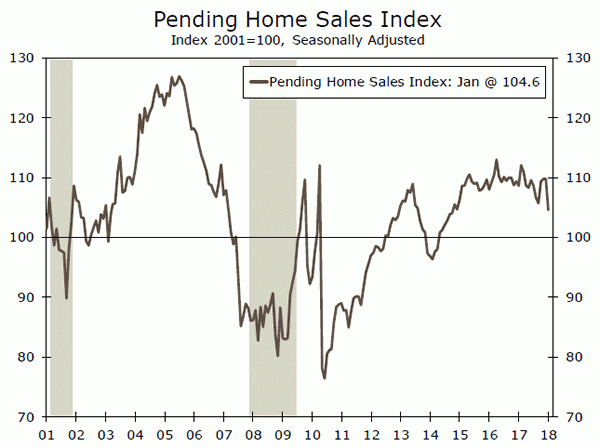
Personal Income • Thursday
Personal income increased a strong 0.4 percent in January while disposable personal income surged 0.9 percent, as Americans paid less in taxes. Stronger growth in wages and salaries and higher social security transfers also added to income growth.
Americans did not completely spend the increase in their incomes; consumption rose 0.2 percent in January, about $103.6 billion less than disposable income. This lifted the saving rate to 3.2 percent of disposable income, from 2.5 percent in December. Sharp declines in the saving rate over the past two years have been raising concerns about consumers becoming overextended, so January’s saving rate increase should help allay those fears. While consumption started the year on a weaker note compared to the last quarter of 2017, the uptick in income growth should help consumers afford to increase their pace of purchases ahead. We expect a recovery in the pace of consumption during the remainder of the year.
Global Review
Rate Hike in May by the MPC Still in Play
- CPI inflation in the United Kingdom fell from 3.0 percent in January to 2.7 percent in February, which could compel the Monetary Policy Committee (MPC) to remain on hold for the foreseeable future.
- But the labor market and the broader economy appear to be performing well, and the MPC has sounded more hawkish in the past month or so. We look for it to hike rates 25 bps at its next policy meeting on May 10.
- We look at effects on the U.S. economy from potential tariff retaliation in the “Topic of the Week” section of this report.
Rate Hike in May by the MPC Still in Play
The Monetary Policy Committee (MPC) at the Bank of England (BoE) decided at this week’s policy meeting to maintain its main policy rate at 0.50 percent, which was widely expected (see chart on front page). The U.K. government mandates that the BoE hit an inflation target of 2 percent over the medium term. As shown in the top chart, the overall rate of CPI inflation has exceeded 2 percent continuously over the past 12 months. The surge in CPI inflation last year reflects, at least in part, the sharp depreciation of the British pound in the aftermath of the Brexit referendum in June 2016. But sterling has stabilized over the past year, and CPI inflation is beginning to recede back toward target. Everything else equal, the MPC would want to remain on hold in coming months to watch the incoming price data.
But everything else is not necessarily equal. Data released this week showed that the labor market is doing quite well at present. Specifically, payrolls rose by 168,000 between October and January, which was much stronger than most analysts had expected. The strong payrolls number helped to push the unemployment rate down to 4.3 percent, the lowest rate in 42 years. The strength in the labor market has caused earning growth to trend higher in recent months (middle chart). Higher earnings growth could raise unit labor costs, which could slow the return of CPI inflation to the BoE’s 2 percent target.
Furthermore, it appears that the economy continues to expand at a reasonable rate in the first quarter. Data released two weeks ago showed that industrial production (IP) jumped 1.3 percent in January relative to the previous month. Although overall IP was pushed higher in January by a one-off surge in the mining and quarrying sector, output in the factory sector rose for the ninth consecutive month. In addition, real retail sales shot up 0.8 percent on a sequential basis in February, although the yearover- year rate of spending growth remains rather lackluster (bottom chart).
The MPC surprised market participants at its last policy meeting in early February when it said that “the UK economy has only a very limited degree of slack,” and that “monetary policy would need to be tightened somewhat earlier and by a somewhat greater extent over the forecast period” than previously anticipated. In its March policy statement the MPC reiterated its view that spare capacity will be used up by the end of next year. Although the MPC voted 7-2 to keep rates on hold this week, the two dissenting members of the committee presumably voted to hike rates.
A few weeks ago we brought forward our expectation of another MPC rate hike, which we had originally penciled in for the August policy meeting, to May due to the more hawkish MPC rhetoric and the incoming data flow. We currently expect that the MPC will then remain on hold until early 2019, but we acknowledge that there is a reasonable probability that it could hike rates yet again later this year. As the MPC itself noted, a major uncertainty facing the U.K. economy remains the Brexit negotiations. If this uncertainty should start to weigh on growth later this year, then the MPC likely will remain on hold after its expected rate hike in May.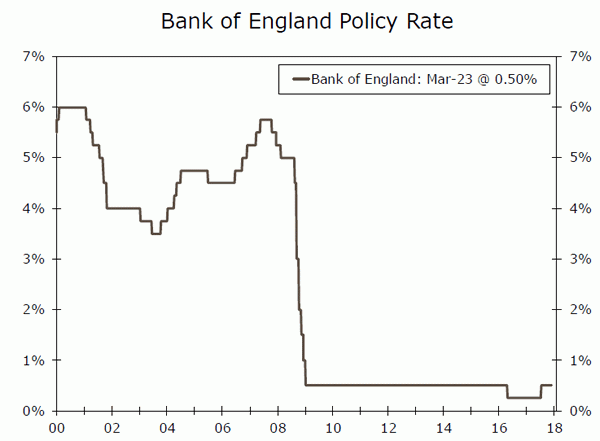
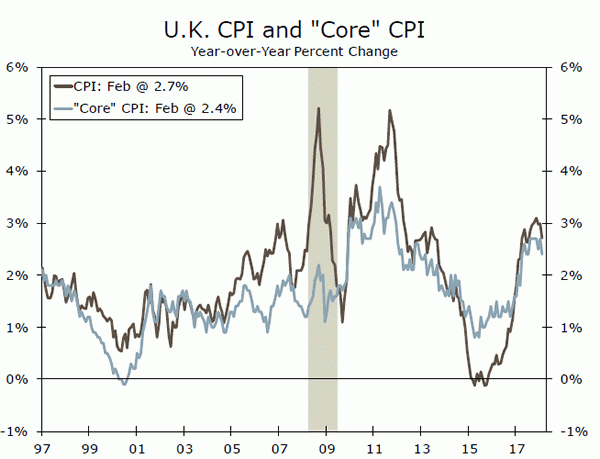
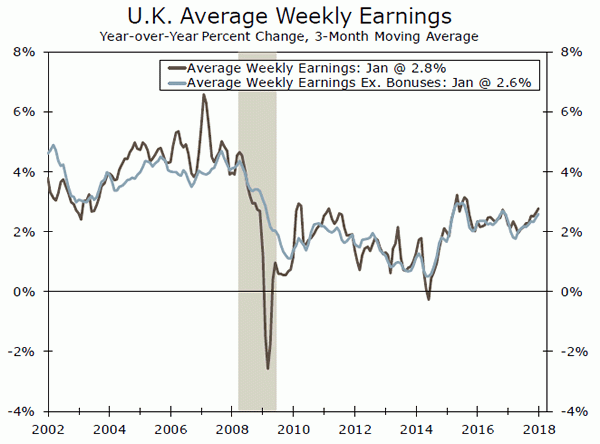
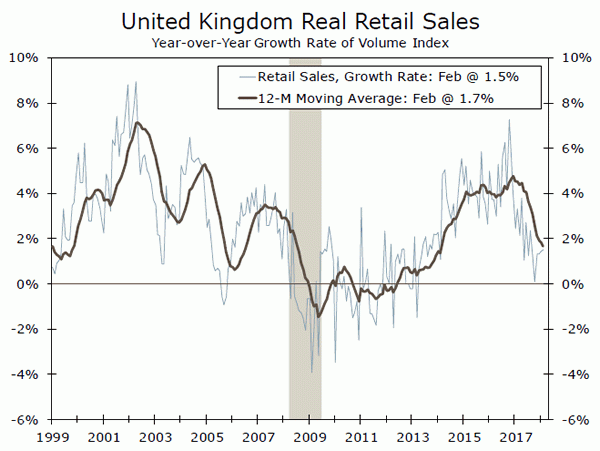
Global Outlook
Canadian Monthly GDP • Thursday
Real GDP growth in Canada came in at a 1.7 percent annualized rate in the fourth quarter. Not only was that a bit below expectations, but the initially reported growth for Q3 was revised a bit lower as well. After growing faster than the rest of the G7 in the first half of the year, Canada’s economy slowed more than initially reported in Q3 and grew less than expected in Q4.
We will get the first look at how GDP is shaping up in the first quarter when the January reading for monthly GDP is released on Thursday of next week.
Previous: 3.3% Consensus: 2.9% (Year-over-Year)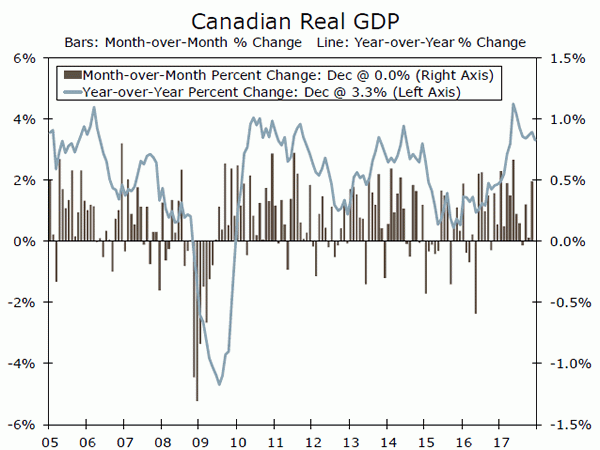
Japanese Industrial Production • Friday
The annualized rate of GDP growth in Japan slowed to just 1.6 percent in the fourth quarter. Business fixed investment picked up after a soft fourth quarter and corporate profits in Japan remain elevated. Business investment has now increased in six of the past seven quarters and suggests a steady uptrend.
Output measures, however, like the monthly industrial production figures have been more unpredictable. In 2017 for example, IP was up seven months but down five. Throughout that year though, IP never declined in back-to-back months.
The current year began with a 6.8 percent monthly decline January, we find out on Friday what happened with Japanese industrial production in February.
Previous: -6.8% Consensus: 5.0% (Month-over-Month)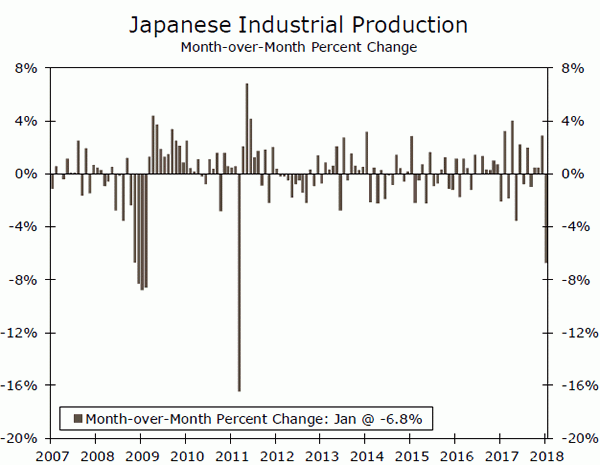
Chinese Manufacturing PMI • Friday
Real GDP growth in China came in at 6.8 percent on a year-ago basis in the fourth quarter which was slightly better than expected. That said, we anticipate a modest slowing in growth in the coming quarters due largely to a retrenchment in investment spending. Although the pick-up in investment spending in the earlier part of the past decade contributed to productivity and output gains, China’s corporate sector is now highly leveraged.
The PMIs give some indication of business activity in China. The official PMI, which offers insight into state-owned enterprises has been trending lower in recent months. The Caixin PMI, which offers an assessment of the small and medium sized companies in the private sector, has been somewhat more resilient.
Friday of next week brings the first look at sentiment in March when the official PMI hits the wire.
Previous: 50.3
Point of View
Interest Rate Watch
Fed Tightens but Financial Conditions Remain Easy
One contradiction for investors today is the contrast between a central bank tightening credit while overall financial conditions remain easy (top graph).
This week the FOMC raised the funds rate with the intention of raising the funds rate two more times this year. In contrast, the financial market conditions index of the Federal Reserve Bank of Chicago, which includes 100+ indices such as the Fed’s senior loan officer survey, yield spreads between CMBS and ABS instruments, the Ted spread and gold, remains negative. This signals credit conditions are easier than on average.
Using this financial conditions index, the outlook for the economy remains positive with no signal of recession.
Quality Spread: Signal from AA Spreads
Spreads of AA corporate bonds relative to the five-year Treasury yield (middle graph) have risen recently but the current spread remains below the recent peaks of mid-2015 to mid-2016. Given the current low ratio of corporate interest expense to cash flow, the ratio does not provide a signal of impeding problems for the overall economy, although there are certainly issues for individual credits.
Quality Spread: Signal from BB Spreads
For high yield bonds the spread relative to five-year Treasury yields (bottom graph) provides even less evidence of a crisis in credit.
Our current outlook is for continued economic growth for the rest of 2018 and into 2019. Our latest recession probability remains below 10 percent.
We do not see that the continued path of the funds rate for the rest of 2018 as representing a threat to the economy.
Our concerns are more focused for 2019 as continued fed funds rate increases meet the reduction of the Fed’s balance sheet and increased Treasury deficit financing. Of course, we add higher inflation, weaker dollar into this volatile mix.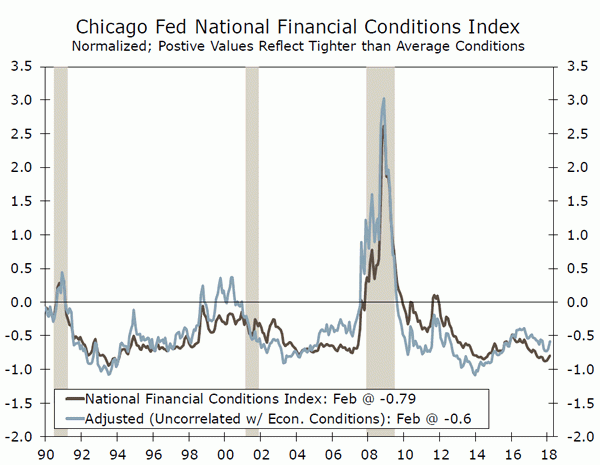
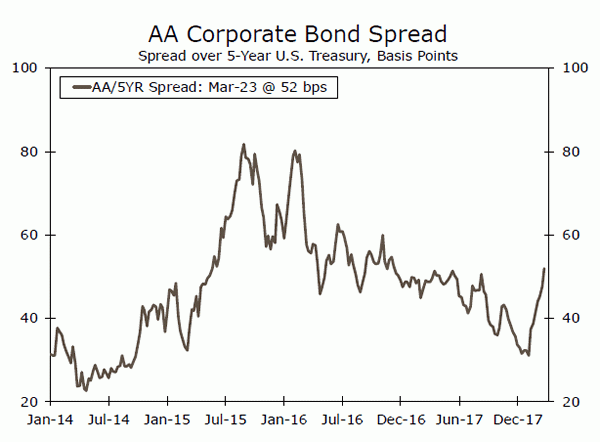
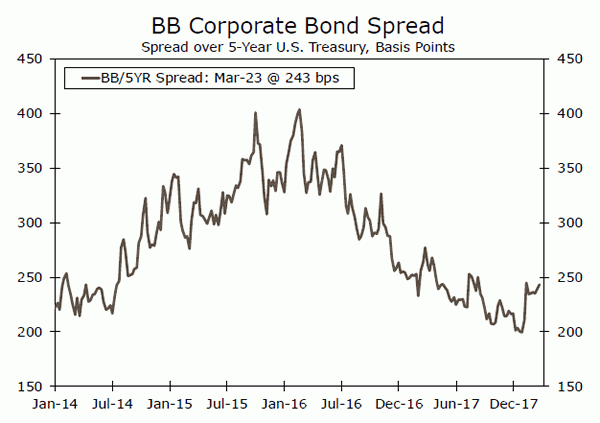
Credit Market Insights
Confidence in Personal Finance
The Bloomberg Weekly Consumer Comfort Index rose this week to 56.8 from 56.2 a week earlier. This measurement has trended sideways for the past six weeks, which can likely be attributed to political uncertainties surrounding trade policies and spooked equity markets. Despite potential pitfalls on the macro-scale, the American consumer remains upbeat. The personal finance gauge rose to 62.9, and is up 2.5 points in the past month, the second-highest level since May 2007. The Bloomberg Consumer Survey of U.S. Economic Expectations also rose, suggesting Americans are still optimistic on future conditions.
So are these optimistic sentiments warranted, or have animal spirits taken too much leash? For starters, personal finances have certainly improved since the Great Recession and default rates on personal loans remain near cycle lows. However, there are a few metrics which may require a second look. For example, the household debt service ratio as a percent of disposable income has trended up the past several quarters after declining for a number of years. Likewise, the debt service ratio for consumer credit continues to move upward, suggesting consumers are financing more and more of their purchases with credit. These metrics on their own do not spell trouble for consumer finances. However, they may suggest difficulties ahead, especially as accommodative monetary policy is withdrawn. We would not be surprised if delinquency rates tick up in 2018 and 2019.
Topic of the Week
Who is Vulnerable to Tariff Retaliation?
President Trump announced on March 8 that his administration would levy 25 percent tariffs on steel imports and 10 percent tariffs on aluminum imports, and he followed up these actions on March 22 by announcing tariffs worth at least $50 billion on imports exclusively from China. China has responded with some minor actions of its own, but it could do much more. The administration has temporarily excluded the European Union (EU) from the steel and aluminum tariffs, but those countries could eventually retaliate if tariffs are instated on them. Which U.S. industries would be most vulnerable to retaliatory steps?
In the top chart we show the percentage of industry value added that is accounted for by exports to America’s most important trading partners outside of NAFTA. (The administration has exempted Canada and Mexico from the steel and aluminum tariffs, so we remove them from the list.) About 30 percent of value added in the “other transport equipment” industry (largely the aircraft industry) is accounted for by exports to America’s top export markets outside of NAFTA. The chart also makes it clear that exports to the EU are an important component of the value added that is generated in that industry. Meaningful proportions of value added in the chemicals, machinery & equipment rental, computer, and machinery & equipment industries are also accounted for by exports to these important trading partners.
Would there be a meaningful macroeconomic effect from potential tariff retaliation? The “other transport equipment” industry accounts for only 0.6 percent of total value added in the U.S. economy. But the 10 industries that are shown in the top chart account for roughly 10 percent of the value added in the economy. An all-out trade war, should one develop, could have a noticeable effect on the U.S. economy.